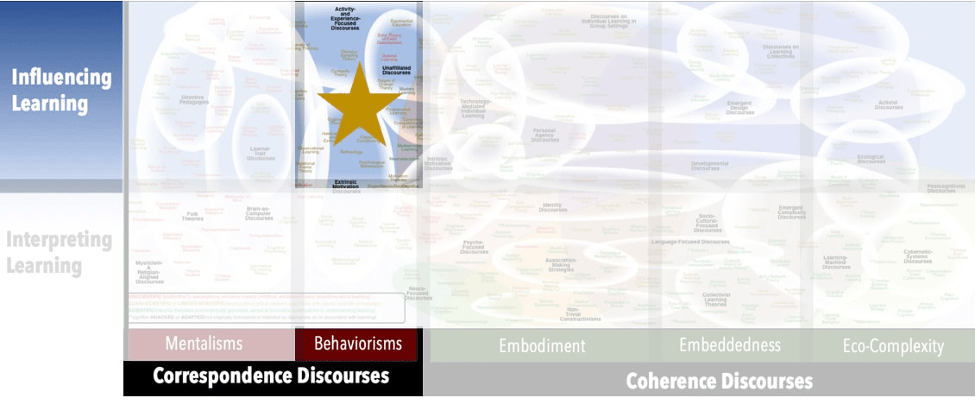AKA
Behavior Change Techniques
Focus
Influencing behaviors, especially dangerous onesPrincipal Metaphors
- Knowledge is … repertoire of behaviors
- Knowing is … learned action, triggered by context
- Learner is … triggered actor
- Learning is … behavior change
- Teaching is … influencing (through manipulation of contextual triggers)
Originated
1990sSynopsis
The phrase “Behavior Change Methods” can be applied to any technique that is intended to influence how people act. While that description is loose, proponents contend that its breadth and imprecision are what render Behavior Change Methods a useful notion – as the open meaning affords wide-ranging considerations of factors, strategies, and measures. To these ends, subdiscourses and associated notions include:- Behavior Change Theories – a broad descriptive phrase that can be applied to any attempt to explain why behaviors change. Its complement is Designs for Behavior Change. Associated discourses include:
- Designs for Behavior Change – a broad descriptive phrase that can be applied to any formal effort to influence behaviors. Its complement is Behavior Change Theories.
- Behavior Change Wheel (Behavior Change Ball) (Susan Michie, 2010s) – a three-level spinner-like graphic used by proponents of Behavior Change Methods to collect and contrast some of the many considerations for influencing human behavior. In sequence, the levels address behavior types, intervention options, and implementation options.
- Behavioral Modeling – [1] broadly defined, any conscious or nonconscious imitation of someone else’s behavior; [2] more narrowly defined, a formal training technique structured around someone with less expertise imitating a demonstration provided by someone with greater expertise (a.k.a., Behavior Modeling; see Social Learning Theory)
- Intervention Mapping – a multi-step protocol developed by proponents of Behavior Change Methods, used to define issues, outline options, select actions, and assess results
- Nudge Theory (James Wilk, 1990s) – a domain focused on the nature and role of “nudges” – that is, small, positively reinforced events (e.g., indirect suggestions) – for influencing the actions of individuals and groups. Associated constructs include:
- Choice Architecture (various, 2010s) – the design considerations around the presentation of sets of options to decision-makers, which might include details such as the number of choices made available, descriptions of those choices, and the identification of a “default”
- Default Effect – within Nudge Theory, one’s tendency to accept the default option – which increases the odds it will be chosen. Thus, defining the default option can be a consequential sort of “nudge.”
- Liberal Paternalism (Richard Thaler, Cass Sunstein, 2000s) – the practice of making subtle changes to another’s environment with a view toward encouraging better choices. The notion combines “paternalism” (in the sense of limiting the choices of another, “for their own good”) and “libertarianism” (in the sense of ensuring one’s right to opt out of specified arrangements)
- Protection Motivation Theory (R.W. Rogers, 1970s) – a postulation that there are four factors that determine self-protective actions: perceived severity, perceived vulnerability, efficacy of response, and perceived agency. Associated constructs include:
- Extended Parallel Process Model (Kim Witte, 1990s) – a postulation for predicting one’s responses to threatening situations, based on Protection Motivation Theory and used to motivate one to action by inducing fear
- Psychological Determinants – as theorized by proponents of Behavior Change Methods, Psychological Determinants are the personality factors that cause people to act the way they do – including, e.g., attitudes, self-efficacy, and habits
Commentary
As noted, the phrase “Behavior Change Methods” encompasses any technique that is intended to influence how people act – which bears the irony of sounding expansive while being narrow. Concisely, even though the perspective attends to multiple and diverse factors that might influence behavior, it does so by isolating such “determinants” and uncritically considering them in linear, causal terms. Perhaps owing to that lack of explicit attendance to underlying assumptions, proponents of Behavior Change Methods draw freely from Motivation Theories, routinely (and problematically) combining principles from multiple Extrinsic Motivation Discourses and multiple Intrinsic Motivation Discourses. In defense of the discourse, it resides most strongly among health care professions, where there would be lesser concern for interpreting the nuances of learning and more attention to the pragmatic concerns of interrupting potentially dangerous behaviors. Nevertheless, with its assumptions of discrete factors and direct causes, Behavior Change Methods could be seen as a half-century out of date (contrast, e.g., Emergent Complexity Discourses).Authors and/or Prominent Influences
DiffuseStatus as a Theory of Learning
Behavior Change Methods are inattentive to the complexities of learning and learners.Status as a Theory of Teaching
Behavior Change Methods are entirely concerned with affecting behaviors, although often in a manner that some would construe more as “manipulating” than “teaching.”Status as a Scientific Theory
Proponents of Behavior Change Methods are quick to label them as “theory-based” – a description that may be problematical on two counts. Firstly, it seems to be offered as a rationale for limited empirical work. Secondly, in this instance, “theory-based” does not seem entail critical attentiveness to assumptions and metaphors. In fairness, with its emphasis on pragmatic impact, there is evidence of efficacy and effectiveness, but the discourse falls short on multiple of our criteria for scientific domains.Subdiscourses:
- Behavior Change Wheel
- Behavior Change Theories
- Choice Architecture
- Default Effect
- Designs for Behavior Change
- Extended Parallel Process Model
- Intervention Mapping
- Liberal Paternalism
- Nudge Theory
- Protection Motivation Theory
- Psychological Determinants
Map Location

Please cite this article as:
Davis, B., & Francis, K. (2025). “Behavior Change Methods” in Discourses on Learning in Education. https://learningdiscourses.com.
⇦ Back to Map
⇦ Back to List
